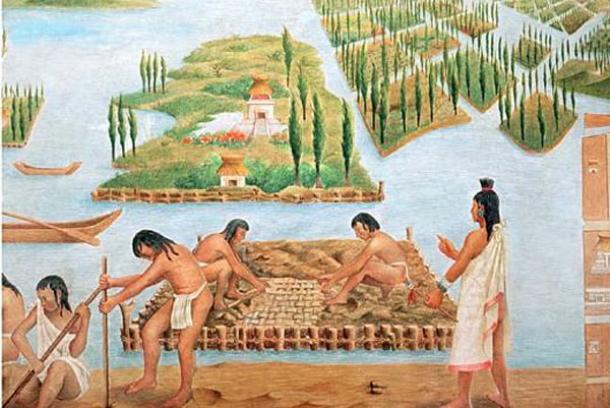Chinampa
Profile; ?>The name ‘Chinampa’ roughly means “weaving fence of canes.†The Chinampa is one of the oldest and most sustainable farming practice that consists of small permanent artificial islands, built on a freshwater lake for agricultural purpose. Recognized as an integrated agricultural system, Chinampa is like a sponge of organic soil that allows the cultivation of diverse agricultural products with highly effective water channels surrounding it. It is one of the best alternative farming techniques for sustainable food production and employment, and it also preserves natural resources.
Located in the Mexico Valley basin (Xochimilco-Chalco sub-basin), this ancient agro-system is still practiced in some parts, mainly south of Mexico. Surrounded by water and structured as rectangular islands 60 cm above the lake water level, it is 5-10m wide and 50-100 or more meters long. Together several such structures form a network with small channels between each Chinampa and other broad channels which provide navigation routes and irrigation water supply.
The ancient Chinampas were built by hand, constantly enriched using organic material from aquatic plants and sediments from the bottom of the lacustrine bodies and supplemented with small amount of animal manure from the vicinity. Recent studies have calculated that a Chinampa of Xochimilco is five and a half times more productive per unit area than the rainfed agriculture.
Developed and adapted more than 3000 years ago by the Meso-American cultures that inhabited central part of Mexico, Chinampa was an innovative idea during its time. The system is still in use and the actual Chinampa area at present is around 25 km2 that can be developed to promote conservation of wetlands, and protect and stimulate the biotic wealth of lake environments.
For its historical and cultural value, in December 1984, the Chinampa zone was declared by UNESCO, a cultural Humanity Heritage. In 2004, it was declared as RAMSAR site by the convention of wetlands. Benefits of Chinampas also include water culture preservation, a natural barrier against the advances of urban sprawl, preservation of wetlands, vital recharge of Mexico City aquifers, and as a diversified ecosystem. The Chinampa also represents one of the ancient irrigation technologies, preserved practically intact, and is funded by the local city government and farmers for its operation and maintenance.
In the recent past, the expansion of the urban areas has encroached upon the Chinampas and the impact has been quite severe as they almost became extinct. The water quality of lacustrine zone was affected severely and overexploited for quenching the water supply demand of Mexico City. As a consequence, local springs dried up and the government decided to supply treated water to Chinampa zones to maintain them. It was estimated that there were about 20,922 Chinampas in Xochimilco, out of which 3,586 are active and the other 17,336 are inactive. Some farmers are adapting their agro-systems such as a greenhouse producing high-value flower on a Chinampa. Average Chinampa size has increased from 221 m2 during Aztec times to more than 2,000 m2 in the last century.
HIGHLIGHTS
Country: Mexico
Province: Mexico City
Latitude : 19.269033333333 Longitude : -99.06945833333333
Built: 3000 years
River: Mexico Valley Basin
Sub-Basin: Xochimilco-Chalco
Irrigated Area: About 25 km2
68th IEC Meeting, Mexico City, Mexico, 2017






